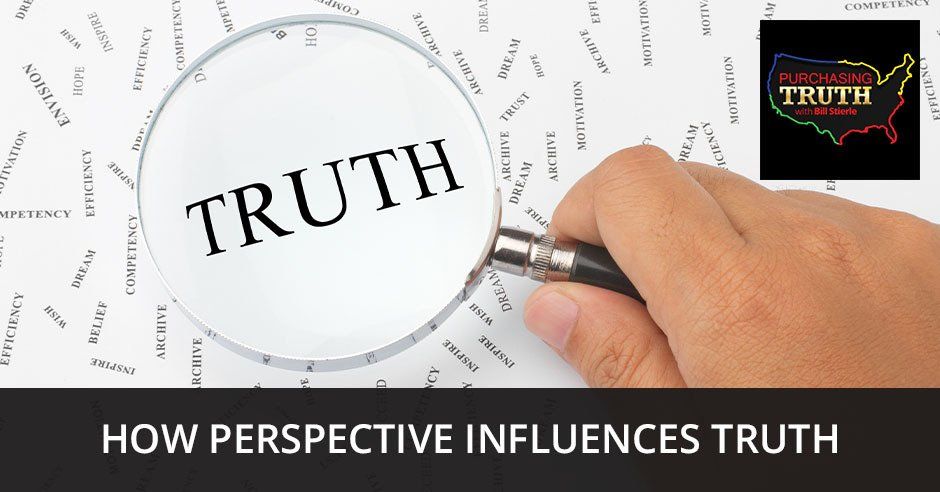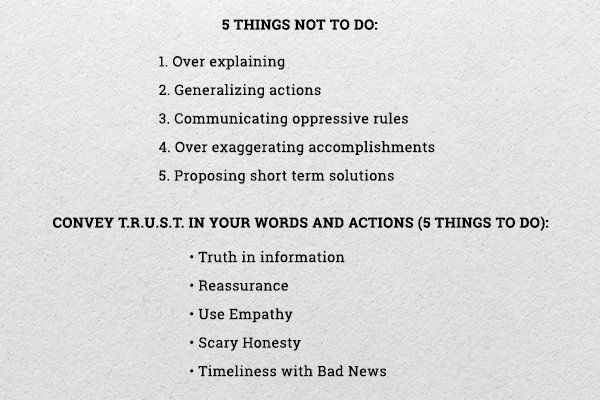Conveying The Truth In Crisis Communication In The Midst Of The COVID-19 Pandemic
Subscribe Today!
Along with the global health crisis we are experiencing around the world is the problem with the truth in crisis communication among our leaders. We are seeing a lot of poor communication about the Coronavirus that is continually spreading and affecting lives. Bill Stierle and Tom get down to the problems in crisis communication that have been affecting how information is absorbed, blurring the lines between truth and misinformation. Bill breaks down five things that should be avoided when relaying information, especially during this time of crisis. On the other hand, he lays down five other ways that could convey T.R.U.S.T. in your words and actions.
---
Watch this episode here
Bill and I have been discussing what we’re going to talk about. We got to deal with the elephant in the world. That is this global health crisis. Talk about truth and crisis communication as we’re seeing a lot of poor communication out there in the world regarding the virus. Maybe I’ll leave it there and not get too detailed. Bill, let’s talk about it.
That’s the hardest part, Tom. There are things not to do in communication and make things worse. Some of the things are obvious, but a lot of things are not as obvious. One of the greatest failures that are taking place is a thing called over-explaining. When you explain too much, the brain is trying to take the information that’s being spoken and referencing inside the listener’s mind. What truth is this? It’s not taking truth as face value. It’s taking truth about the person’s experience. For example, if there is a story that comes off that there’s this big storm going to hit the shore or a big hurricane. In California, we have the storms that come up from the South that are big and went everything down every couple of years or so, El Nino. If a person doesn’t have the storm as bad or didn’t have experience as a bad thing for them, they’ll say, “That wasn’t that bad. I was inside. I was dry.”
Meanwhile, 0.5, 2, 5, 10 miles away from them, there was this flood that took out 30 houses. For them in their mind, it wasn’t that bad of a storm, like a normal rainstorm. It’s not that big. The hurricane wasn’t all that bad. When we explain things or even overexplain things, the brain will numb itself and validates its truth versus take what you’re saying at face value. It becomes either not scary because the person has rejected it or scary because the person in the past lived in a city that got flooded. As soon as any little rainstorm or water stream shows up, they think that within fifteen minutes, they will be washed away like their favorite dog was. I could make it worse from that. These are the things not to do is to overexplain. News media is getting stuck in explaining things. Instead of delivering a message that starts with a fact or a value and then, works toward a positive truth and something that we can rely upon that is both honest and also not explains too much.
In crisis communication, one of the things that happen also, many politicians get stuck here is they generalize the action. They generalize their behavior. They make it broad and hard to hold them accountable for something. One of the things that they struggle with politicians because politicians have to watch out for is that they’ve got to get votes from both sides. They’ve got to get enough people to believe them. They can’t fall too hard on one side or too hard on another side. Certain politicians are making a lot of good work on falling hard on one side, keep promoting that one side is true and hope the other side can’t build up enough steam and momentum against them. Codify what they would like and know that the other side will get stuck into overgeneralization and overexplaining, which is what you saw in the debate of partly what you saw in politicians and candidates that did not gain any traction above 5%. They had a fire for a minute, but not enough to create the next moment.
Regrettably, they weren’t able to move and engage. Let’s not go down too far down that rabbit hole. Let’s stay down on how can news media get better? How can communication during crisis get better? There are some people will float and communicate in an oppressive rule. When they communicate an oppressive rule, immediately that allows them to have exposure from the other side that says, “Look at that person, they’re taking your choices away. They’re overreacting because they’re putting that rule in place. What do you mean not to go out to restaurants?” Meanwhile, with some better communication and some more planning ahead of time, which is for safety and stability for the nation. That’s what governments for is to advocate fairness and legal responsibility for those at one level and then a lot of freedom at the top. An oppressive rule gets everybody’s energy. Tom, I want to go out to a restaurant so that I can feed the economy.
I can’t do it because of the protection and the safety that was not put in place ahead of time to get the testing done, to see what the numbers were and where they were. We don’t know where they were. There’s this blanketing thing that needs to take place to take swaths of the economy out of action. To do what we do here, which is talk remotely so that you and I are not in the same room together, which makes it a viable business. You can reach your fan base. You can reach your people because they don’t have to be in the same room. Yes, live events are wonderful, but I know one person that canceled her live event of 900 people and had to throw $2 million under the bus because of it.
There are many more examples of that.
Conferences and the NBA had to lose millions of dollars. There was no choice because we didn’t test early and it got out of hand. We did not take what was offered to us as a nation. The World Health Organization, “We have these test kits. Use them.” “No, we’ll wait. We have time. We’ll develop our own.”
Is that leadership?
That struggles because the amount of money it took place because of the loss will slow down. First, we’re going to be treading water and some of us are going to drown because we’re treading water. We’re going to be tired and not know where to swim barely. Hopefully, some of us are going to get that life ring, but not all of us are going to get a life ring because the economy had slowed down. It’s not going to end in July or August. This is going into a full downturn that is going to be exhausting and tiresome that this is going to take place. Regrettably, it’s something we need a lot of compassion and empathy for because of the impact of the belief. Are there ways to get us out of it sooner? Yes, there are some ways. Is there the capability and leadership communication available? No, there’s not.
It’s glaringly apparent that the administration, their communication, their messaging is being led right from the top and that it is lacking in many of these ways. These five things you say not to do are happening a lot. That it seems like a great point for us to segue into number four, which the occupant is prone to, would you agree?
I agree. The number four is the over-exaggeration of accomplishments. I’m going to over-exaggerate that when the virus came to our shores with the military that was in the general region and those members were infected, we quarantined that and then sent a message that we’re not taking people from that nation that are going to allow us to travel here. We’re not allowing those people to travel because they might be bringing the virus with them. Every time he goes back to that, the over-exaggeration of that action, that accomplishment and it’s generalized and over-exaggerated. It’s like, “No, you can’t.” What happens is that truth and trust are the casualties then.
Number five on our list, which is proposing short-term solutions, “We’ll only do it this little thing. We have plenty of testing kits everybody could get tested. That’s where it’s going to be.” I’m going to say something weird because it’s not Donald Trump’s fault. The reason why that’s a weird sentence is that when somebody is brought up to language, marketing, promotion, sales, and branding, these five things are what do you need to do when you’re marketing, promoting and branding something. You need to generalize what this product is going to do. You need to make a firm commitment about something it partially does and says, “This thing is the best pizza ever. Better pizza, better ingredients.” Papa John’s to give them a shout out. No, it’s not. It’s not better ingredients, better pizza.
They even took what the court over it with Pizza Hut. It said, “No they’re not better ingredients and they’re not better pizza. No, they’re not.” The court has ruled in Papa John’s favor that it’s up to the buyer to decide what’s better and not better. The objective was for Papa John’s not to put they’re “Better ingredients, better pizza” next to Pizza Hut. They can’t do that anymore. They can still say the sentence, “Better ingredients, better pizza,” but they cannot go after someone else’s brand that comparing my pizza to your pizza. The win was that Pizza Hut got them to stop doing comparing their pizza with their pizza. The losses to the end consumer where somebody gets to over-exaggerate their accomplishments and generalize their pizza-making skills.
I had forgotten that story. It seems like they each had a victory in some way and then they each got a pie in the face in some ways. Papa John’s said, “You can say that about it, but you can’t do this.” Pizza Hut got a victory and said, “They can’t put us side by side with them and smear us on this thing.” At the same time, they didn’t get what they wanted either. They didn’t get them a ruling that said, “Your ingredients are not better.”
The generalization that the court allows with language allows a lot of variations for things to be interpreted. This is problematic because there are certain parts of the country where there are certain rules in place that the nation does a swoop down and do anything about it. I would call some of these rules and oppressive rules their atrocities. They’re oppressive to the people that live in that state, in that area. Over-exaggerating accomplishments. These five things, overexplaining. We don’t want to overexplain too much. Give the fact and put a piece of information by it the people can start down the path. The acronym that I came up with is to restore TRUST and we want to convey TRUST. The first letter and trust is T, truth in information. Give the facts, bring bad news. Here’s the fact, tell me the number. Measure it and then be honest, if you haven’t measured it. If you didn’t make enough tests, you made a mistake. Fall on the sword, you can keep your integrity as you keep going.
Number two R, reassurance. Give reassurance that’s based on accurate information, not the reassurance that’s generalized. “That’ll be over soon. We’re ahead of this.” “We’ve done a wonderful job. Here’s a sheet of paper.” This sheet of paper says, “I’m doing a wonderful job.” That’s like somebody at home shopping network holding up a testimonial and saying, “John of Spokane, Washington says, “This is okay, and this is the difference he made for him.” Again, generalizing, pulling one piece of testimonial that’s written well to sell something. Not to run a stable government where you’re protecting people in lives as well as protecting the economy. If you think about it, these are elements that did not make the economy tank during the three pandemics that Barack Obama had to go through. The economy did not tank on those three things but ours is going to tank.
Ours is taking a big hit already and we’re still not even midway through this thing.
Communication messaging is a roller coaster.
I’d say it’s a train wreck to label it. I have a question to you about the underlying needs after we get through the rest of your trust acronym.
The next one is U. It is something that I had to think about a little bit is how do we use empathy for the top five things that took place there? They’re doing their best to explain something complex where they need to tell the truth there. They’re giving us a piece of information that has a partial truth to it. That’s a generalized action that the person has done. I see that they’re looking to do a rule. If they apply that rule there, it’s going to affect and cause a cascade of trust not taking place. Empathy is one of those things where when we talk about what the need is and the feeling that goes with it. We can calm the feeling down and calm down the reaction. You’ve got to watch the next thing that comes out of your mouth. Donald Trump comes out and says, “Things are not bad.” He starts a State of the Union address and he uses the five things in the State of the Union address. I’m going like, “I don’t have any hair to pull out.” It’s not wise to have a State of the Union address that does overexplaining, generalization, an oppressive rule, an over-exaggeration of complement and a short-term solution. How could you not do all five in an address? The stock market right down because there’s no trust left at the end of it.
There’s no belief among the people that he has anything under control. That’s the trust that’s missing. What’s after use empathy?
The next is scary honesty. You got to talk about your mistakes openly and it doesn’t mean you have to do shame or guilt around it. You’ll have to do blame around it. You got to do honesty. The messaging doctor, the one that’s the infectious control doctor is doing scary honesty. The marketing person, the branding person doing counter messages to the scary honesty. What happens is that the person in charge of the infectious the communication with this crisis is gaining more respect, more recognition, more trust, more acknowledgment. We’re not believing the other person. It’s one of President Donald Trump’s successful formula by not allowing anybody to be above him in expertise to always hire people that are below his skillset level or at a higher skillset level but do his deeds or clean up his mess for him. They have done that. They’ve brought in languaging messaging people that ally in front of the Senate and not to a trial and to talk themselves out of it because there are not the votes.
It’s similar to the person that Donald Trump put in place of the justice department, Bill Barr. It’s much what you were describing. It’s much the same. Bill Barr, I’m sure is much smarter than the president when it comes to legal matters in general, but he is clearly at the direction of if not under the control of he being the president won’t let Bill Barr do certain things. He’s got to do it Donald Trump’s way demonstrated that he’s willing to do that.
Notice that Bill Barr said you brought him up, also uses the five things not to do in a crisis. What he does is he puts this in place because he knows the short attention span of the American media cycle that we run out of steam. He can use those five things in general, non-crisis experiences like the Mueller Report. Redact things that are not supposed to be redacted to protect his client. That’s what we’ll discover.
Put your opinion, which doesn’t matter. It doesn’t have any weight or any bearing, but you put an opinion that reveals some things about the report. You minimize it. You proportionalize it saying, “Here’s what’s there. There’s no there.” You take a lot of wind out of the sails of the whole effort.
Truth doesn’t have any place to sail to. We are the ship in the storm with limited leadership rudder and a limited ability to go someplace, to find safe ground to get out of the storm. The storm’s going to long and it needs to. The last one in our acreman after scary honesty is timeliness with bad news. It’s called to bring bad news. You’ve got to be timely about bad news. Initially, you hear bad news and you go like, “Is this the best moment for this bad news?” Usually, the answer is sooner than later. It is not holding this back and see if we can make this weight, which is what they do in recalls. They don’t recall things right away. The ones that recall things get a lot of respect and recognition and acknowledgment when they do. They take the step and their brand gets to be known as, “Wait a minute.” For example, when Johnson & Johnson pulled all of their stuff off the shelf. Rebottled it, recapped it with the protective seal. They pulled it all off and they did it instantly.
Is this the Tylenol cyanide thing from the ‘80s?
That would be years ago. I’m dating myself even. They got long-term brand recognition by bringing bad news and acting on that bad news. “They pulled all the things off the shelf first and then did not put the seal cap on it.” It did happen twice. What happened? They pulled it off again and they said, “What’s the way to give the consumer certainty that we have done our part to meet the need for safety?” We got to change the bottling industry and put this protective sealant on it, which is the industry standard of all bottles that we open up in the United States.
Not just medicines, a lot of foods are similar.
Foods have that sealant on it. We adjusted fine.
Do you remember when you used to buy a jar of peanut butter? You would unscrew the lid. Anybody in the grocery store could have unscrewed the lid and seeing the peanut butter and people who grew up thinking, “The jar could have been opened?” The idea that it could have been opened and tampered with is otherworldly to people. It’s like, “You open up the lid and there isn’t that one time seal? You do not know?” No, we didn’t have that.
This is a great example of safety, protection and a way to get trust. How do you get trust? You do scary honesty. How do you do scary honesty? You bring bad news early. What do you do when somebody gives you some BS? You give them empathy for the BS that they gave you with the generalization, the rule, the over-exaggeration. The belief about safety is to shut the borders. The scary honesty with that thing is it’s an overreaction. It is an oppressive rule. That too little, too late, and you’re doing your best over there. You have the thought that this rule is going to make a big difference, but it’s a talking point in your list of things to reinforce and to pump up the exaggeration that you’re a person of accomplishment.
This is not accomplishing anything. It’s not helping us. I make the decree that within the 30 days, there will be enough testing kits for every American to take one. I commit to 30 days of that and then communicate bad news as it goes. How are you going to do 336 million test kits for all the people in the United States? Within 60 days, we will have 300 million test kits for everyone to get tested. Generalizing, but I’m making a commitment. Notice that there’s no empathy and no reassurance and people go, “BS, that’s not honest.” Honestly, within the 30 days, we will have, how many test kits?
It’s not believable because it’s seen as wishful thinking rather than putting some context on it. You give them some measure of certainty that within this amount of time, we’ll have it. It’s good. It’s interesting, Bill, what you talked about before in terms of bringing out the bad news early. It’s much what we tell kids. My six-year-old has a band-aid on that needs to come off. This band-aid is gotten dirty in the sandbox. It’s making the wound worse than it did when it was protecting it and we need to rip the band-aid off and that’s going to have some short-term pain, but it’s going to be better in the long run. The interesting thing and you’ll like this analogy. I still remember my CPA in my business when I lived in the Midwest.
When it came to certain things like taxes and rules, he was a good account. He knew what he was doing but he said, “I’m not here to be your conscience.” When there was a potential, something of bad news or bad outcome that might happen, there was another strategy he had an expression he had and I’ve used it ever since. It’s called T-minus eleven. I was like, “What does that mean?” It’s like, “Did you ever see the space shuttle? Whenever there’s a countdown hold, it happens at T minus eleven seconds.” Anything before that, not after that because once you get the T-minus ten, you’re launching.
You’re trying, whether you succeed or fail, you’re going to pull that trigger, push that button. A lot of times with the space shuttle, there was a government contractor who made a satellite or made some other device going up or is responsible for some system. All these contractors knew that if they were the one that holds up the countdown, they’re the ones that get a bill for a $1 million-plus a day holding up the shuttle. All these contractors are waiting until T-minus eleven before they admit, “We got an issue, we need to stop this launch.” They’re waiting to see who flinches, hoping that the other contractor flinches first ends up paying the bill and then they’re not the ones that have to pay the bill. I much see what the communication coming out from The White House has been.
This is a poor strategy, even with the space shuttle and all that. Wouldn’t everybody liked to know this problem and start dealing with sooner rather than later because it cascades into more problems? They’re all hoping either for something else is going to happen. Some other circumstances are going to happen. They’re hoping and Donald Trump’s been hoping this problem was going to go away and not get as bad. As I’ve learned in business in my career, and I’m admittedly similar to the president, my experience comes from business. Hope is not a strategy. You can get lucky once or twice maybe but you cannot make success through hope in business. I also think in crisis management like this thing that we’re dealing with.
Hope falls into a category of overgeneralization. It’s a great marketing piece, but it is not a strong piece to accumulate trust. You can’t accumulate trust with hope. Isn’t that interesting? It only gets you far. I’m getting flashbacks of President Obama’s poster that had the word hope on it. It’ll get him elected but once he’s there, if he’s not down here bringing information, giving reassurance, empathy, scary honesty and timeliness, he’s not doing that.
Hope would not have gotten us out of the 2008 financial crisis. He had to do hard work. His administration had to be the adult in the room. Make the hard choices, bring the scary honesty, the truth around what we need to do as a nation to pull ourselves out of that ditch.
Communicate evenly, all of his communications were measured.
Another word I’d like to add to that is intentional. Measured is correct. I agree with you, Bill, but intentional, there was no riffing in those press conferences. There was no winging it from the gutter instinct. This was calculated and purposeful.
It’s regrettable that President Donald Trump only has one speed. It’s called being on the political trail and promising things that he can’t deliver.
He’s still trying to gives the sizzle.
He’s coming back around to all of them, the wall, all of the talking points. It’s still swampy here. How are you defining the swamp? The swamp has changed. It’s more exposed and even worse.
The swamp has gotten worse because the swamp of the past still had much more truth within it than it has. Truth has become such a casualty of the new swamp. We still got a lot of the same senators, the same players. You’ve got Mitch McConnell there and Lindsey Graham. Even on the Democrat side, you got Chuck Schumer and Dianne Feinstein. You’ve got a lot of the same players there. The issue is truth has changed things much and it’s what you were talking about the five things not to do. At some point, we got into a conversation there about how things happen one-sided. The messaging gets much to one side with these politicians. It is amplifying their message, trying to drown out the opposing message. That has brought us down further into the swamp and as a more divided nation. To me, nothing has been done to drain the swamp. It’s amplified it.
It’s exasperating. Our need for truth isn’t met. It’s exhausting because the need for progress isn’t met. We’re going to face it down economy. What I’d like to do, Tom is to roll up our sleeves a little bit and look at how to apply empathy for these negative messages that keep coming in our direction so that we’ll have a little bit of compassion when Donald Trump does open his mouth and does say something that doesn’t meet our need for truth. We don’t have to use anger. We can use something different. We can use compassion and empathy for, “It looks like the president is trying to provide people some hope where we need some accuracy.” Saying what he’s doing is he’s looking to make an impression of leadership instead of providing us the accuracy that we need. A lot of the politicians that get on TV are missing this. They get stuck in explanation too. Let’s see if we can provide some contribution to them and our readers that we can get a better sense of what to do and how to work our way out of this?
It sounds good, Bill. I look forward to that.
Thanks for this, Tom.
Love the show? Subscribe, rate, review, and share!








